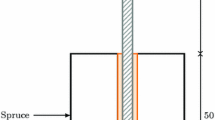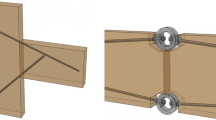Abstract
In the construction and rehabilitation of wooden structures, timber connections are often made using glued rods. To guarantee that these connections provide adequate resistance, it is necessary to analyse the characteristics of the connections that affect their load capacity and ductility. To address this issue, the mixed strategy of developing a broad experimental program was adopted while simultaneously performing numerical analysis of models. In this paper, the finite element method is used to study the impact of several design parameters on stress transfer between materials. This approach has facilitated design strategies that improve the effectiveness of these connections.
Zusammenfassung
Bei der Errichtung und der Sanierung von Holzkonstruktionen werden häufig eingeklebte Gewindestangen als Holzverbindungen verwendet. Um sicherzustellen, dass diese Verbindungen hinreichend zuverlässig sind, ist es notwendig, die Ursachen, die ihre Tragfähigkeit und Duktilität beeinträchtigen können, zu untersuchen. Dazu wurden ein breitangelegtes Versuchsprogramm und gleichzeitig eine numerische Modellierung durchgeführt. In dieser Studie wurde die Finite-Elemente-Methode verwendet, um den Einfluss verschiedener konstruktiver Parameter auf den Spannungsverlauf am Übergang der Materialien zu untersuchen. Dieser Ansatz hat die Entwicklung von Bemessungsstrategien, mit denen die Leistungsfähigkeit solcher Verbindungen verbessert werden kann, ermöglicht.












Similar content being viewed by others
References
Aicher S, Hofflin L, Wolf M (1998) Influence of specimen geometry on stress distributions in pull-out tests of glued-in steel rods in wood. Otto Graf J 9:205–217
Bainbridge R, Mettem C, Harvey K, Ansell M (2002) Bonded-in rod connections for timber structures. Development of design methods and test observations. Int J Adhes Adhes 22:47–59
Broughton JG, Hutchinson AR (2001) Pull-out behaviour of steel rods bonded into timber. Mater Struct 34(2):100–109
Buchanan AH, Deng XJ (1996) Strength of epoxied steel rods in glulam timber. In: Proceeding of the International Wood Engineering Conference, New Orleans, pp 488–495
EN 338 (2009) Structural timber. Strength classes. CEN European Committee for Standardization
Estévez J, Otero D, Martín E, Vázquez JA (2012) New anchoring system with adhesive bulbs for steel rod joints in wood. Constr Build Mater 30:583–589
Guitard D (1987) Mechanics of wood and composite materials (in French). Cepadues Edition, Toulouse
Gustafsson PJ, Serrano E, Aicher S, Johansson CJ (2001) A strength design equation for glued-in rods. In: Proceeding of the International RILEM Symposium, Stuttgart, Germany
Johansson CJ, Serrano E, Gustafsson PJ, Enquist B (1995) Axial strength of glued-in volts. Calculation model based on non-linear fracture mechanics. A preliminary study. In: International Council for Building Research Studies and Documentation, Working Commission W18—Timber Structures. Meeting 28, Copenhagen, Denmark
Kurian A (2000) Analytical modeling of glued laminated girder bridges using Ansys. In: 2000 Transportation Scholars Conference, Ames, pp 54–64
Martín E, Estévez J, Otero D, Muñiz S (2006) Timber specimens parametrized design for numerical analysis. In: Proceeding of the International Conference on high performance structures and materials III, Ostende, pp 571–580
Martín E, Estévez J, Otero D, Vázquez JA (2010a) Generation of numerical analysis models for the optimization of anchorage solutions with threaded bars glued in timber. In: Proceeding of the World Conference on Timber Engineering (WCTE 2010), Riva del Garda, Italy
Martín E, Estévez J, Otero D, Vázquez JA (2010b) Numerical analysis of metal joints glued in timber pieces. In: Proceeding of the First International Conference on Structures and Architecture (ICSA 2010), Guimaraes, Portugal
Otero D, Estévez J, Martín E (2008) Glued joints in hardwood timber. Int J Adhes Adhes 28:457–463. doi:10.1016/j.ijadhadh.2008.04.008
Otero D, Estévez J, Martín E (2009) Influence of the geometric and material characteristics on the strength of glued joints made in chestnut timber. Mater Des 30:1325–1332. doi:10.1016/j.matdes.2008.06.041
Otero D, Estévez J, Martín E (2010a) Experimental analysis of bonding in steel bars glued into chestnut and tali timber (in Spanish). Materiales de Construcción 60((297)):111–125
Otero D, Estévez J, Martín E (2010b) Influence of timber density on the axial strength of joints made with glued-in steel rods: an experimental approach. Int J of Adhes Adhes 30:380–385
Otero D, Estévez J, Martín E (2010c) Model for predicting the axial strength of joints made with glued-in rods in sawn timber. Constr Build Mater 24:1773–1778
Otero D, Estévez J, Martín E, Vázquez JA (2010c) Failure modes in double-side pull-out test of threaded steel rods glued in hardwood. In: Proceeding of the World Conference on Timber Engineering (WCTE 2010), Riva del Garda, Italy
Riberholt H (1986) Glued bolts in glulam. Department of Structural Engineering, University of Denmark, Denmark (Serie R No. 210)
Rossignon A, Espion B (2008) Experimental assessment of the pull-out strength of single rods bonded in glulam parallel to the grain. Holz Roh Werkst 66:419–432
Senno M, Piazza M, Tomasi R (2004) Axial glued-in steel timber joints. Experimental and numerical analysis. Holz Roh Werkst 62:137–146
Serrano E (2001a) Glued-in rods for timber structures. A 3D model and finite element parameter studies. Int J Adhes Adhes 21:115–127
Serrano E (2001b) Glued-in rods for timber structures. An experimental study of softening behaviour. Mater Struct 34(4):228–234
Steiger R, Gehri E, Widmann R (2006) Pull-out strength of axially loaded steel rods bonded in glulam parallel to the grain. Mater Struct 40(1):69–78
Volkersen O (1938) Die Nietkraftverteilung in zugbeanspruchten Nietverbindungen mit konstanten Laschenquerschnitten. Luftfahrtforschung 15:41–47
Acknowledgments
This research is sponsored by the Ministry of Science and Technology through research project titled ‘‘UNIONES METÁLICAS ENCOLADAS CON ADHESIVOS EN BARRAS DE MADERA” (Glued Anchored Timber Joints). The financial support is gratefully acknowledged.
Author information
Authors and Affiliations
Corresponding author
Rights and permissions
About this article
Cite this article
Martín, E., Estévez, J. & Otero, D. Influence of geometric and mechanical parameters on stress states caused by threaded rods glued in wood. Eur. J. Wood Prod. 71, 259–266 (2013). https://doi.org/10.1007/s00107-013-0678-3
Received:
Published:
Issue Date:
DOI: https://doi.org/10.1007/s00107-013-0678-3




